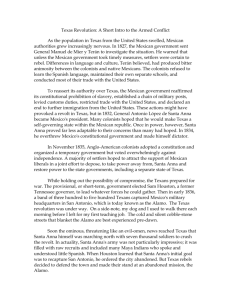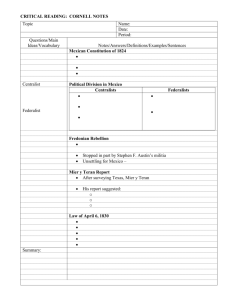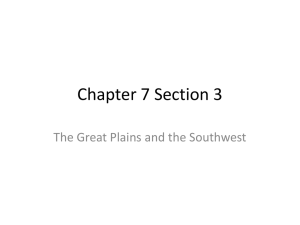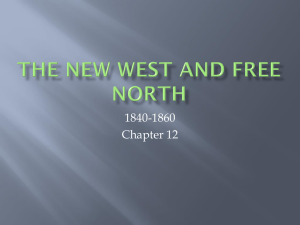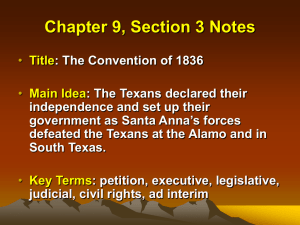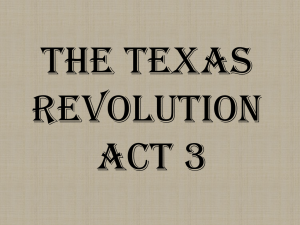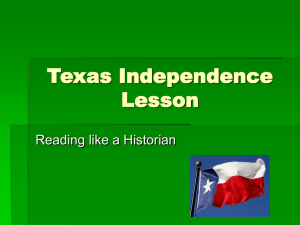Lecture 10
advertisement
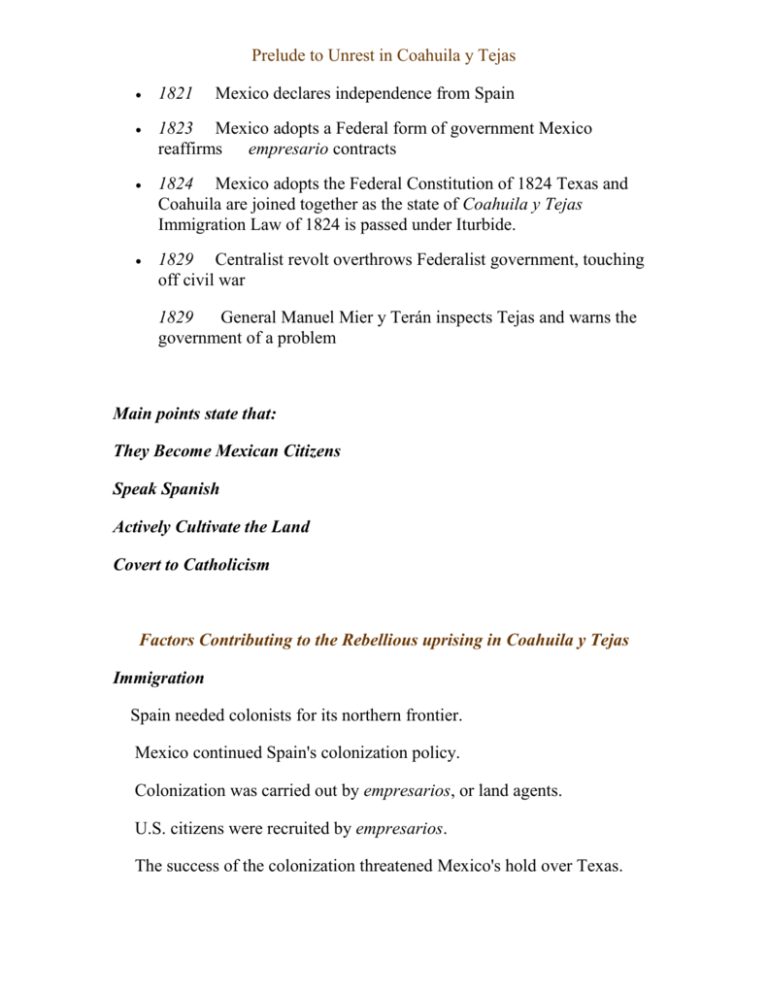
Prelude to Unrest in Coahuila y Tejas 1821 1823 Mexico adopts a Federal form of government Mexico reaffirms empresario contracts 1824 Mexico adopts the Federal Constitution of 1824 Texas and Coahuila are joined together as the state of Coahuila y Tejas Immigration Law of 1824 is passed under Iturbide. 1829 Centralist revolt overthrows Federalist government, touching off civil war Mexico declares independence from Spain 1829 General Manuel Mier y Terán inspects Tejas and warns the government of a problem Main points state that: They Become Mexican Citizens Speak Spanish Actively Cultivate the Land Covert to Catholicism Factors Contributing to the Rebellious uprising in Coahuila y Tejas Immigration Spain needed colonists for its northern frontier. Mexico continued Spain's colonization policy. Colonization was carried out by empresarios, or land agents. U.S. citizens were recruited by empresarios. The success of the colonization threatened Mexico's hold over Texas. Ideology The American Revolution sparked a world-wide republican movement. The old monarchial system was challenged by radical new ideas. Revolutions occurred in France and throughout the Americas. Not everyone favored radical change. Conflicts broke out between those wanting change and those wanting to maintain the existing social order. In Mexico, those wanting change were called Federalists and those wanting to maintain the status quo were called Centralists. Federalist support tended to be strongest in frontier regions like Texas. Native born Federalist in Texas had much in common ideologically with immigrants from the United States. Economic Factors Mexico retained Spain's colonial system of restrictive trade. Official ports-of-entry were at Veracruz and Acapulco. Official trade was conducted through Mexico City. Regions distant from Mexico City resented extra time and taxes imposed on them. The system promoted political discontent and smuggling. Texas historically looked to Louisiana for cheaper goods. Economic ties reinforced the bond with American colonists. Texas drew American colonists because public land in the U.S. cost $1.25 per acre while land in Texas could be obtained for 12 cents per acre. Footer of page 119 2 Arms in defiance of the national constitution. We appealed to our Mexican brethren for assistance: our appeal has been in vain; though months have elapsed, no The Mexican government fearing upheaval in Tejas passes on April 6 1830, Anglo-American Immigration: The April 6, 1830 Law The Rebellious uprising in Coahuila y Tejas 1832 Santa Anna backs a Federalist counter revolution Colonists in Texas confront Centralist garrison at Anahuac Colonists adopt Turtle Bayou Resolutions supporting Santa Anna Colonists meet to discuss their concerns over lack of input on government 1833 1834 Santa Anna returns to office to stop V.P. Gómez Farías' liberal reforms C. y T. legislators split Texas into 3 departments increasing Federalist control Austin released from jailed but not allowed to leave Mexico City Santa Anna disbands the existing Mexican Congress and forms a new one C. y T. declares Santa Anna's action illegal, announcing its opposition to him Federalists and Centralists in C. y T. divide into armed camps 1835 Mexican Congress elects Santa Anna president Santa Anna retires to his estate and allows his vice-president to govern Colonists reconvene and send Austin to Mexico City to ask for statehood Austin is arrested for anti-government activities and jailed C. y T. legislators vote to move state's capitol from Saltillo to Monclova Federalist revolts break out in several Mexican states Santa Anna and Cos crush revolt in Zacatecas Colonists in Texas confront Centralist garrison at Anahuac once more Santa Anna sends Cos to put down revolt in Coahuila y Tejas Governor of C. y T. changes capitol to Béxar but is captured by Cos Austin is allowed to return to Texas and calls for revolt against Centralists 3 Cos issues arrest warrants for rebel leaders and tries to disarm Texans Fighting breaks out on October 2 at Gonzales over "Come Take It" gun Centralist Congress announce plan to convert states into "departments" and produce a new constitution along the Centralist model Austin leads "Army of the People" to San Antonio de Béxar The Consultation calls for restoration of Federal Constitution of 1824 Cos and his garrison under siege throughout November Texans force Cos to surrender Béxar but allow him and his army to leave Brief Chronology of Events Concerning The Alamo October 9, 1835 - General Martín Perfecto de Cos arrives at San Antonio de Béxar, bringing the number of Centralist forces in the town to approximately 1,200 October-November 1835 - Texian forces gather outside San Antonio de Béxar - Centralist troops fortify the town, including the Alamo October 28, 1835 - Texians defeat Centralists in skirmish near Mission Concepcion November 26, 1835 - Texians capture pack train bringing forage for Cos' cavalry December 4, 1835 - Colonel Benjamin R. Milam rallies Texians for an assault on Cos' garrison in San Antonio de Béxar December 5-10, 1835 - Battle of Béxar rages as Texians fight their way into town - Cos surrenders his army, which is then paroled December 21, 1835 - Colonel James C. Neill receives orders to take command at San Antonio de Béxar - garrison consists of about 100 men January 19, 1836 - Colonel James Bowie arrives to investigate the military situation for governor Henry Smith and General Sam Houston 4 February 2, 1836 - Bowie and Neill vow ". . . we will rather die in these ditches than give it up to the enemy." Lieutenant Colonel William B. Travis arrives with 30 men February 8, 1836 - Former Congressman David Crockett arrives in San Antonio de Béxar with 12 volunteers February 14, 1836 - Travis and Bowie agree to share command at San Antonio de Béxar after Colonel Neill received a temporary leave of absence February 23, 1836 - Antonio López de Santa Anna and the Centralist forces arrive and the Siege of the Alamo begins March 1, 1836 - Constitutional Convention at Washington on the Brazos. Texans are undecided on what to do next and break into factions? March 2, 1836 - Texas declares independence on March 2. March 6, 1836 - The Alamo falls in a predawn assault March6 1836 - The Alamo reoccupied by Centralist forces March 1836 Santa Anna reorganizes is army and makes the fatal mistake of splitting the commands under Filisola, Cos, and Castrillion. News of the Alamo's fall sets off the "Runaway Scrape" Houston withdraws his forces eastward Fannin's command is executed by Santa Anna on March 27 in Goliad Provisional government of Texas caught up in the exodus to the east Houston defeats the Mexican vanguard at San Jacinto on April 21 Santa Anna is captured on April 22 Santa Anna and Texas officials sign the Treaty of Velaso on May 14 May-June1836 - Centralist forces are ordered out of Texas following Santa Anna's capture at the Battle of San Jacinto - the Alamo's fortifications are destroyed by the Centralist garrison 5
